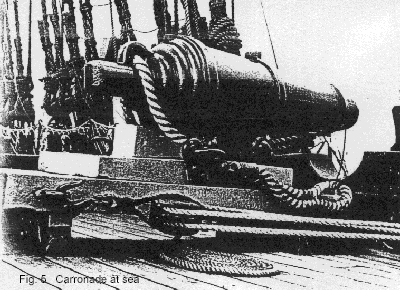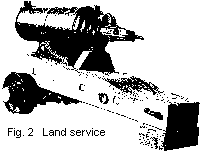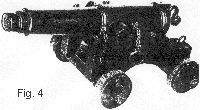|
The Carronadeby WL RuffellThe two large cast iron pieces in the Maritime Display of the Auckland Institute and Museum are short guns called 'carronades' so named because ordnance [1] of this nature was first made by the Carron Ironworks Company [2], situated at Carron near Falkirk, Scotland.
Charles Gascoigne [3], manager of the Company from 1769 to 1779, is said to have 'invented or rather improved' the carronade, and for a short time it was known as the 'gasconade'. However, Lt Gen Robert Melville and Patrick Miller, an Edinburgh banker, were also associated with its development, and some of the larger pieces were at first called 'melvillades'. The carronade was designed especially for the Navy who adopted it in 1779. It was manufactured in sizes ranging from 6 to 68-pounder [4], and was widely copied by other firms both in the UK and the USA. Thus many variations in dimensions will be encountered. During the era with which we are concerned (1750-1860), all ordnance was smooth-bored and muzzle-loading. Hitting power of even the most efficient guns fell off rapidly at ranges over 900 metres, while the poor ballistic shape of projectiles, excessive windage [5] and crude methods of laying [6] brought effective ranges down to the 400-700 metre bracket in calm seas. As conditions worsened heavy guns became harder to handle [7] and effective ranges progressively shorter. In offensive operations the object usually was not to sink an enemy vessel but rather to avoid damaging the hull so as to capture it more or less intact as a 'prize' [8]. Fighting men have ever been spurred by thoughts of loot! In training great emphasis was placed on gun drill for the Navy never opened until they were certain they could obtain hits. By this time the opposing ships were often only a few metres apart, and gun crews had to make the very best of the limited time available before the target went out of their arc of fire. The heavier the impact of the initial onslaught upon the enemy the easier he would be taken. Therefore the side with the best-trained gunners had a distinct advantage. Battle began with an exercise in seamanship, at which the British always excelled, each ship manoeuvring for a position from which it could inflict the maximum punishment upon the other while enduring the least itself. A favoured technique for an attacking vessel was to run across the stern of his adversary, raking his decks with each of the broadside guns in turn. Outmanoeuvred in this way the enemy could not bring his main armament to bear and suffered many casualties to men and equipment. Inevitably much damage was done to masts, rigging and upper work in the process, but this did not worry the prospective prize-winner. Once the prize was taken such damage could be repaired without too much trouble, and in the meantime the greater the chaos of tangled ropes and spars aboard the opposition the better. It lessened his capability to retaliate. The preliminaries over and the victim floundering the attacker would then 'run alongside', secure with grappling irons and send over a boarding party. Cutlass and pistol then decided the issue. Now the inventors of the carronade knew of these tactics; also they had observed that a heavy round shot striking a wooden ship at what passed for high velocity in those days (about 400 metres per second) punched a fairly clean hole with few splinters. On the other hand the same shot striking at a much lower velocity had a greater smashing effect and generated many more splinters, a very important aspect as sailors well knew splinters caused nearly as many wounds as other missiles. If the Navy had a gun to suit their tactics, i.e. one of low muzzle velocity and short range, so much the worse for His Majesty's enemies. The short, stubby piece that Carron produced supplied the answer. It was an innovation when innovations were difficult to sell, when the official attitude was 'what was good enough for our grandfathers is good enough for us', but the canny Scots had wrought well. Both the Treasury and their Lordships at the Admiralty were suitably impressed, and after the usual trials the carronade was accepted. Carron claimed the following additional advantages for their brainchild:
The carronade became very popular with sailors who nicknamed it 'the smasher' after characteristics already mentioned. On ships otherwise conventionally armed carronades were usually installed on forecastle and quarter deck. However, owing to their popularity and in keeping with current tactics, a number of ships were armed with carronades alone. They proved very successful until the enemy woke up and insisted on fighting at gun range!
They were probably mounted on common sea service or ships' carriages similar to the one shown in Fig. 5. Those carriages were made of elm because it was tough, had less tendency to split than other woods, and therefore did not splinter to the same extent. The wheels or 'trucks' were usually of larger diameter in the front to allow for the camber of the deck, the idea being that the carriage came level when 'run out' to the port in the ship's sides providing the ship was on an even keel. The smaller and more badly corroded carronade appears to be a 12-pr, i.e. it fired a cast iron round shot weighing 12 lbs (5.44 kg). Its propellant charge of gunpowder consisted of 1 lb (453 g) and at an elevation of 5° it would have achieved a range [11] of 1000 yards (913 metres). Unfortunately no markings are discernible. The larger and better preserved piece labelled 'Horeke, Hokianga' is a 24-pr, charge 2 lbs (907 g), range 1150 yds (1052 m) at 5°. On the breech the weight 12-2-11 (12 hundredweight 2 quarters 11 lbs) (639.7 kg) can still be read, as can the date of manufacture, 1808. Round shot was the standard projectile but spherical shell, case or canister, and grape could be fired - plus anything else suitable for the occasion, as indicated by the caption below Fig. 5! Shell were filled with powder and fuzed with a wooden fuze driven into a hole in the shell prior to loading and ignited by the flash from the propellant charge. Shell were fitted with wooden discs or 'bottoms' to ensure the fuze remained facing the muzzle when fired. Case or canister comprised a cylindrical tin box, filled with balls of musket size or larger, and produced a shotgun effect. Its purpose was purely anti-personnel. Grape in its early versions consisted of a number of iron balls tied up with canvas or netting and resembled a bunch of grapes. After 1856 the projectile consisted of four iron plates between which were placed three layers of iron shot varying in size according to the calibre of the gun, i.e. for small guns the shot might have been of a few ounces but for larger guns say two or three pounds each. The assembly was held together by a bolt passing through the middle. Grape was intended primarily to cut rigging, but could be used against small boats, and naturally caused numerous casualties among crew members. It became obsolete in the Navy in 1866. Grape was never used in bronze guns (sometimes loosely referred to as 'brass') because it damaged the bores. Propellant charges of the correct weight were made up into cartridges. Various materials were used, at first paper then flannel and finally serge. Loading and firing were carried out in a strict sequence as follows:
In laying the old-time gunner relied to a great extent on experience and upon the performance of his own particular piece. He sighted 'along the line of metal', i.e. along lines scribed on the barrel for line, and made use of other lines on the side of the gun for elevation. Some carronades had a foresight on the muzzle or second reinforce stepped to form a guide for elevation as well as line. Around 1779 the tangent sight, similar in principle to the common rifle sight, was introduced but some years elapsed before it was universally adopted. Lord Nelson said he was prepared to try the new sight but was not very enthusiastic over it, because, he said, when he attacked he 'closed' with the enemy and sights were unnecessary.
NOTES1. 'Ordnance' is the correct generic term to use when referring collectively to projectors which use explosive force to propel a projectile in the direction of the enemy, with the exception of small arms. On its own the barrel of a gun, mortar, howitzer or carronade is a 'piece of ordnance'. The carriage is a separate part of the complete equipment. 2. Inaugurated in 1759 by Dr John Roebuck in cooperation with members of the Caddell family and still operating. In 1762 the Company commenced producing ordnance and munitions. Their products were highly esteemed by both Army and Navy. 3. In 1779, possibly through disagreement over credit for the invention, Gascoigne emigrated to Russia taking with him several skilled members of the Carron staff. Catherine the Great appointed him to organise her Ordnance Department at the then fantastic salary of �4500 a year, showered him with decorations and eventually promoted him to General! 4. Guns and carronades were classified according to the weight of the cast iron round shot they fired. Calibres of carronades were as follows according to tables dated 1850: 6-pr 3.6 inchesAs stated elsewhere there was some variation. These figures do not apply to guns the calibres of which were somewhat greater in each case e.g. a 24-pr gun made in 1812 was 5.82 inches. 5. Windage is generally reckoned as the difference between the diameters of bore and shot; more correctly it is the difference between their cross-sectional areas. It was necessary:
Against the necessity had to be set the disadvantages; it caused:
6. The procedure of pointing a gun in the direction of a target and elevating it in order to achieve the required range. The gunner who carries out the procedure is called the 'layer'. 7. The Navy allowed in its gunnery establishment one man for every 500 lbs (227 kg) weight in each complete equipment (gun and carriage). Hence a 24-pr gun weighing about three tons had a crew of 13 men. 8. Such prizes (if they made it to port) were either sold by auction or retained and put into service by the State. The proceeds or value in the latter case were credited to the crew winning the prize who subsequently received 'prize money'. The system was legalised in 1793. Prize money is still payable In the Royal Navy but not in the Army where the equivalent terms were 'booty of war' and 'booty money'. 9. For example, the 68-pr gun fired 22 lbs (10 kg) of powder, but the 68-pr carronade only 5 lbs 10 oz (2.55 kg). 10. These were the rammer, sponge etc. 11. The range quoted is extreme range, not effective range. At 1000 yards it would do little damage to a ship. 12. This procedure was called 'serving the vent'. So important was it considered that if the breech number did not have his thumb over the vent at the crucial moment the man at the muzzle had permission to hit him over the head with the rammer! 13. Flintlocks were officially adopted in the Navy in 1790. In earlier days the tube was fired by a slow match kept in a tub in rear of the gun, or by the 'portfire', a paper tube filled with a slow-burning mixture.
WL Ruffell |

 When first introduced the carronade was made as in Fig. 1, i.e. with a loop underneath through which fitted a pin holding it to the carriage and at the same time allowing it to be elevated or depressed.
When first introduced the carronade was made as in Fig. 1, i.e. with a loop underneath through which fitted a pin holding it to the carriage and at the same time allowing it to be elevated or depressed.
 According to its intended role it was mounted on a carriage designed for sea service (Fig. 5) or land service (Fig. 2) - the Army used a few in coastal fortifications. This method of construction made the carronade very handy in action but also tended to make it unstable.
According to its intended role it was mounted on a carriage designed for sea service (Fig. 5) or land service (Fig. 2) - the Army used a few in coastal fortifications. This method of construction made the carronade very handy in action but also tended to make it unstable.  Consequently in later years carronades began to be made with trunnions (Fig. 3) and mounted on carriages similar to the normal sea service gun carriage (Fig. 4). Both Museum carronades are of the trunnioned variety.
Consequently in later years carronades began to be made with trunnions (Fig. 3) and mounted on carriages similar to the normal sea service gun carriage (Fig. 4). Both Museum carronades are of the trunnioned variety.
